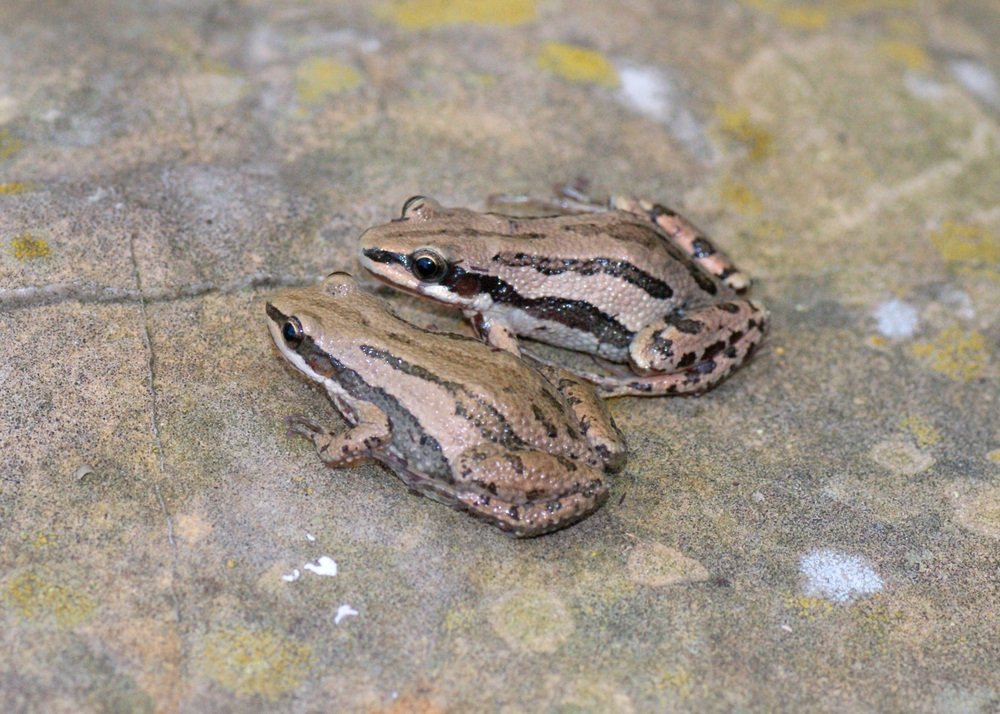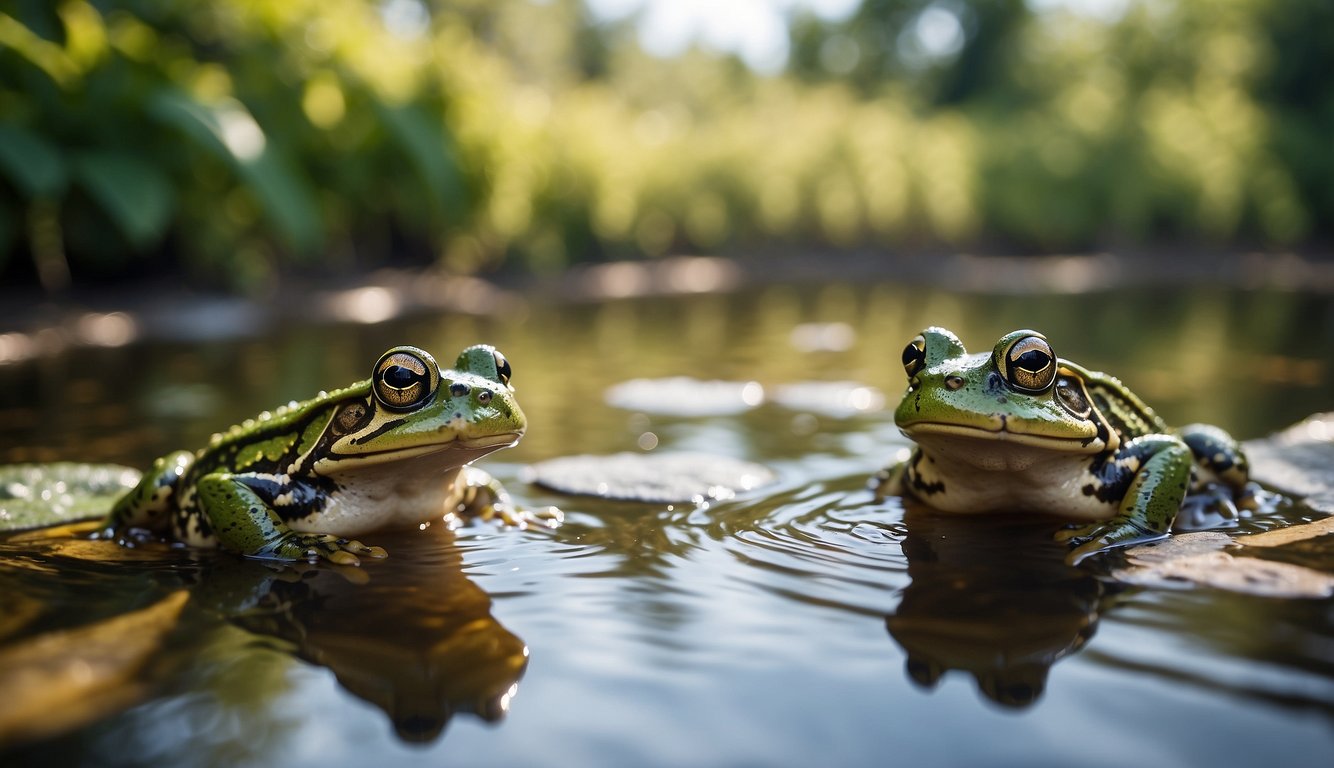Reducing Frogs in 9 Easy Steps
Step 1: Identify Attraction Factors
- Question: Have you identified what is attracting frogs to your property?
- Yes: Proceed based on specific attractions.
- No: Look for water sources, abundant insect populations, and sheltered spots that might attract frogs.
Step 2: Remove Water Sources
- Action: Eliminate or modify water bodies where frogs breed and live.
- Methods:
- Ponds and Pools: Cover pools when not in use and install fences around ponds. Consider filling in unnecessary ponds if legally permissible.
- Standing Water: Remove standing water where possible to reduce breeding sites.
- Methods:
Step 3: Reduce Food Supply
- Action: Decrease the insect population that serves as food for frogs.
- Pest Control: Implement environmentally friendly pest control measures to reduce insects.
- Yard Maintenance: Keep grass mowed and reduce outdoor lighting that attracts insects.
Step 4: Modify Habitat
- Action: Alter or remove frog hiding places.
- Debris and Clutter: Clear away brush, leaf piles, and other debris where frogs may hide.
- Landscaping: Adjust landscaping to be less inviting to frogs by using less dense plantings and more open spaces.
Step 5: Use Natural Deterrents
- Question: Would you prefer using natural deterrents?
- Yes: Implement natural repellents.
- Vinegar Spray: Create a mixture of vinegar and water to spray around the perimeter of your property. The smell and acidity help deter frogs without causing long-term harm.
- Salt Barriers: Spread salt around the edges of your property; however, use this sparingly as it can harm plants and soil health.
- No: Consider other non-chemical methods.
- Yes: Implement natural repellents.
Step 6: Physical Barriers
- Action: Install barriers to prevent frogs from entering specific areas.
- Fencing: Use fine mesh or solid fencing around gardens, ponds, and other sensitive areas to physically block frogs.
Step 7: Humane Removal
- Action: Relocate frogs if necessary.
- Methods: Gently capture frogs and relocate them to a suitable nearby habitat where they are permitted to be released. Use gloves and a container with air holes.
- Legal Check: Ensure that relocation is in accordance with local wildlife laws, as some species are protected.
Step 8: Consult Professionals
- Question: Are you unable to manage the frog population on your own?
- Yes: Consult with a wildlife expert or herpetologist for advice and assistance.
- No: Continue with effective measures and regular monitoring.
Step 9: Regular Monitoring and Maintenance
- Routine Actions:
- Check and Maintain Barriers: Regularly inspect and repair any barriers or deterrents.
- Monitor Water and Habitat Changes: Keep an eye on any new developments in your yard that might attract frogs.
Additional Tips
- Avoid Chemicals: Avoid using harsh chemicals in your yard as these can harm frogs and other wildlife.
- Education: Learn about the ecological benefits of frogs, such as their role in controlling insect populations, which might influence your approach to managing their presence.
Safe and Natural Deterrents
When looking to send those hoppy visitors packing, aim for gentle, earth-friendly methods.
Here’s how you can turn your yard into a no-frog zone without any harsh chemicals.
Creating Unwelcoming Habitat
- Eliminate Water Sources: Frogs love water, so ensure you keep your yard dry where possible.
Repair leaky faucets and ensure proper drainage so puddles don’t linger.
- Trim Vegetation: Keep your grass short and bushes neat.
A tidy garden offers fewer hiding places for your amphibious guests to settle down.
Natural Predators to Encourage
- Install Birdhouses: Attract birds that feed on frogs by putting up birdhouses.
Make sure they are in a quiet and high location for the best chance to entice winged frog-patrol agents.
- Welcome Snakes: While it might not be your first choice, snakes are natural predators of frogs.
By tolerating non-venomous snakes in your garden, you tap into nature’s pest control.
Home Remedies to Repel Frogs
- Vinegar Spray Solution: Create a repellant by mixing equal parts water and vinegar.
Spritz around the edges of your yard, especially where frogs are common.
- Citric Acid Mixture: Dissolve citric acid in water and apply to areas frequented by frogs.
This natural remedy is a non-lethal way to keep them at bay. Use sparingly and responsibly to avoid harm to plants and other wildlife.
Physical Barriers and Removal
To keep those hoppy friends out of your yard, it’s all about the barriers and getting a little hands-on when necessary.
You’re essentially creating a no-frog zone with some ingenuity and a bit of elbow grease.
Setting up Exclusion Fences
- Materials: Use smooth, solid materials like PVC or metal sheeting.
- Height: Ensure it’s at least 24 inches high; frogs are not olympic jumpers, but they’re spry!
- Depth: Dig in at least several inches—frogs aren’t diggers by nature, but let’s not take chances.
Steps:
- Measure your perimeter first, so you know how much material you’ll need.
- Plant posts at medium intervals for stability.
- Attach your fencing material securely to these posts.
- Bury the bottom of the fences to prevent frogs from slipping underneath.
Install a low fence around your garden to keep frogs at bay.
Hands-On Frog Relocation
- Safety First: Wear gloves to protect yourself and the frogs from any potential harm.
- Gentle Grab: Handle them with care – a soft touch is key.
Process:
- Look for frogs at dusk when they are most active.
- Carefully scoop the frog up and place it in a carrying container such as a bucket.
- Transport and release the frog into a more suitable and safe environment far from your property.
If you happen to have quite a few jumpy friends to move, consider making a frog-friendly habitat elsewhere to welcome them to their new home.
Environmental Control
In your quest to reclaim the serenity of your yard from unwelcome frogs, focus on reshaping your environment to be less hospitable to these amphibians.
Here’s how you can turn the tide in your favor.
Water Feature Management
- Drain birdbaths, ponds, or pools that aren’t in use. Frogs need water to thrive; remove their habitat, reduce their numbers.
- Clean regularly: Ensure water in ponds or fountains remains clear with routine cleaning to discourage frog eggs and larvae.
- Fill in or fix: Any areas where water may pool can be invitations for frogs.
Repair leaks and fill in hollows where water may gather.
Garden Maintenance Tips
- Trim and Tidy: Overgrown vegetation offers shelter for frogs. By keeping your yard neat, you make it less appealing.
- Mow your lawn regularly.
- Trim bushes and shrubs to let in more sunlight.
- Moisture Management: Frogs love moist environments, so it’s important to regulate watering.
- Water your plants sparingly, focusing only on what’s necessary for their health.
- Remove Shelter: Look for and clear out any debris or clutter like leaf piles and old logs where frogs may hide.
Chemical Repellents and Solutions
When dealing with frog invasions, chemical repellents can offer a straightforward solution, but it’s essential to handle them responsibly both for your safety and the environment’s well-being.
Commercial Frog Repellents
- Ready-to-use sprays: These repellents are convenient and typically contain ingredients like citric acid or vinegar that frogs find irritating.
- Concentrated liquids: For larger areas, these can be diluted with water and sprayed throughout your yard.
- Granular products: Scatter these around the perimeter of your space to create a barrier that frogs would rather not cross.
Remember to always read and follow the manufacturer’s instructions for safe and effective use.
Legal Considerations for Chemical Use
- Regulations: Check your local and federal laws as some substances may be regulated or banned in your area.
- Environmental impact: Consider the potential harm to non-target species and ecosystems, as chemicals can affect more than just frogs.
- Application and cleanup: Ensure you understand the correct way to apply and dispose of chemical repellents to avoid legal repercussions and ecological damage.
Prevention and Long-Term Strategies
To effectively deter frogs from your yard, adopt consistent prevention tactics and consider creating alternative habitats to redirect their presence.
Regular Property Checks
- Trim Vegetation: Keeping your yard well-maintained with trimmed grass, bushes, and trees deters frogs by removing their favorite hiding spots.
- Water with Care: Overwatering your garden creates ideal conditions for frogs. Water your plants sparingly to keep the moisture level low.
Creating a Frog-Friendly Area Away from Home
- Dedicate a Zone: Allocate a section of your property, away from your house, to encourage frogs to populate that specific area.
- Select a corner that’s naturally moist and shaded.
- Add a small water feature and plant varieties that provide ample cover and food sources for frogs.
Frequently Asked Questions
Discover effective and safe methods to address your amphibian concerns with the following common queries.
What are effective natural remedies to keep frogs away?
- Create an environment that’s less appealing by keeping your yard clean and free of overgrown vegetation.
- Explore the use of vinegar solutions or coffee grounds to create natural deterrents.
What steps can I take to prevent frogs from entering my house?
- Seal any small openings and cracks around doors and windows to block entry points.
- Ensure to close the drapes to minimize light attraction that might lure frogs closer to your abode.
Which repellents are considered the best for deterring frogs?
- Commercially available products containing citric acid have shown to be effective frog repellents.
- Saltwater spray is another option; it can discourage frogs from traversing certain areas, similar to its effect on slugs.
How can I safely remove frogs from my swimming pool?
- Install a frog log or a ramp to give frogs an escape route from the water.
- Cover your pool when it’s not in use to prevent these amphibians from taking a dip.
Are there any home solutions for stopping frogs from settling on my porch?
- Reduce outdoor lighting which can attract insects, subsequently luring frogs.
- Regularly sweep away any bugs and use a vinegar-based spray around the porch to discourage frog visits.
What methods can I employ to discourage toads from taking over my yard?
- Remove standing water sources like buckets or overturned pots which can serve as breeding grounds for toads.
- Keep grass mowed and maintain a tidy garden space to lessen the habitat toads seek out.
Last update on 2025-03-28 / Affiliate links / Images from Amazon Product Advertising API





